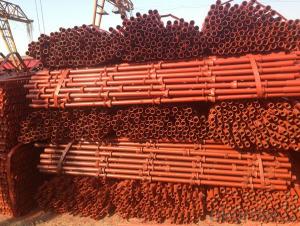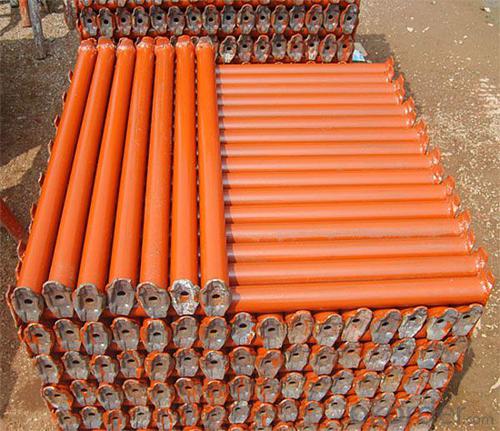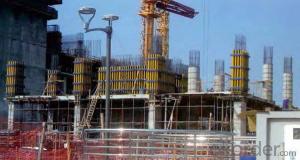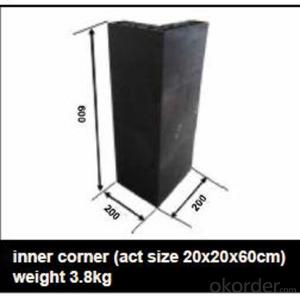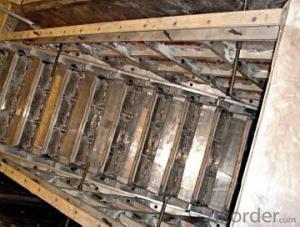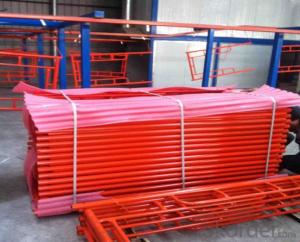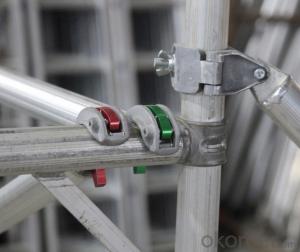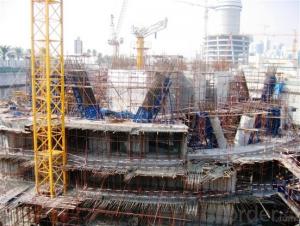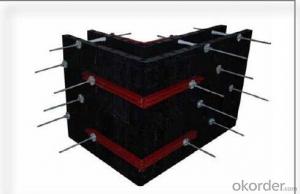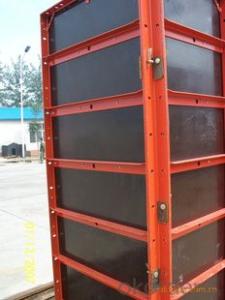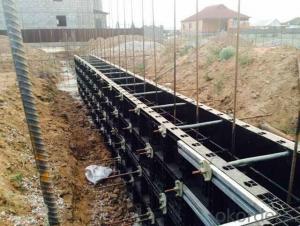Wedge Lock Scaffolding Formwork Aluminum Stair Scaffolding Cnbm
- Loading Port:
- Tianjin
- Payment Terms:
- TT OR LC
- Min Order Qty:
- 10000 set
- Supply Capability:
- 50000 set/month
OKorder Service Pledge
OKorder Financial Service
You Might Also Like
Wedge Lock Scaffolding Formwork Aluminum Stair Scaffolding CNBM
Frame Scaffolding Systems Formwork Bs Standard Scaffolding Tube With Low Price
Developing with new technology materials, steel formworks is no longer a must in construction concrete process. More and more buildings are established with plastic formworks. And workers love this new formworks much more.
The advantages of plastic formworks:
1.First of all--light
Yes it is the first advantage of plastic formwork. It wins the great praise of both contractors and workers.
The biggest panel is 120×1500px,weights 10.5kg only. It can be lift and set up by one person easily, which means there is no need for cranes on site.Saves a lot of cost and time.
2.Easy set up
Different size of panels can firmly locked by simply turn the special handles to 90 degree. The Panels has rib on the back, which makes the system need not traditional wood blocks and nails. The panels have holes to fit tie rod, guarantee the strength of the whole system.
3.Modularity
Modular formworks composed by different size of panels,the main item is 120×1500px panel,which is used for the large area of walls and slabs. There are also small size of panels like 10×1500px,20×1500pxcm,25×1500px,inner corner 20×20×1500px and outer corner 10×5×1500px.Due to the variety of panel size, the system can form almost all size walls 120×1500px panel of multiply by 125px. The material of modular formwork is PC-ABS mixed with special glass fibers which enable panels to hold high pressures.
4.Strength
The handles are made by high strength Nilon, each panel locked by at least 4 handles, which makes the whole system strong enough to pour 1000px walls.
5.Environment friendly
The system needs no cut and nail due to the variety size. Also it needs nearly no wood. The material can be recycled after broken, so it will not pollute the environment.
6.Consequent
Concrete does not stick to plastic formwork, thus the panels need no oil before using, and can be cleaned simply by water. The surface of the wall which build by modular formwork is smooth and without rework.
Wedge Lock Scaffolding Formwork Aluminum Stair Scaffolding CNBM
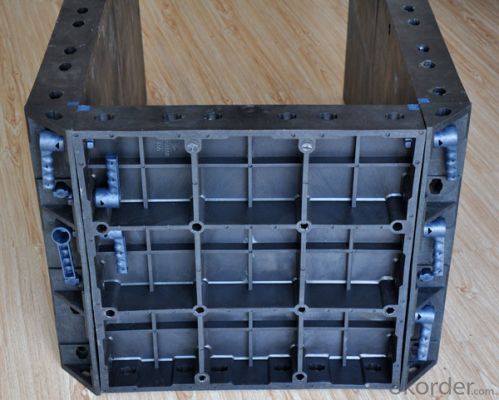
Wedge Lock Scaffolding Formwork Aluminum Stair Scaffolding CNBM

Wedge Lock Scaffolding Formwork Aluminum Stair Scaffolding CNBM
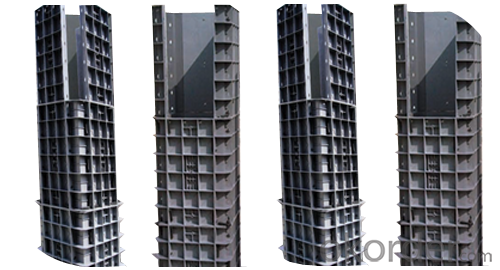
Advantage
* Good loading capacity
* Easy to assemble and dismantle
* Stable and durable thanks to its structual design & automatic welding quality
* Customized solution helps you work safe, save cost and convenient
* Excellent quality for formwork & scaffolding with wide choices
Wedge Lock Scaffolding Formwork Aluminum Stair Scaffolding CNBM
Packing
in bulk or in bundle, or as requested
Shipping
15-20 Days.
Normally small orders, it needs just 15-20 business days to the port. For goods with stock, it would be even shoter.
Wedge Lock Scaffolding Formwork Aluminum Stair Scaffolding CNBM
Other scaffolding & formwork products:
(1) Scaffolding System:
Including Ringlock Scaffolding System and accessories; Cuplock Scaffolding System and accessories; Kwikstage Scaffolding System and accessories; Haki Scaffolding System and accessories;
(2) Scaffolding Frame & Accessories:
Including Walk Through Frame Scaffolding; Ladder Frame Scaffolding; Accessories; we also can make scaffolding according to your samples or drawings.
(3) Scaffolding Couplers/Clamps:
We can produce all kinds of forged and pressed couplers, including British type couplers, American type couplers, German type couplers, Italian type couplers ,fence couplers, BRC coplers and so on. We also can produce according to your drawings or samples.
(4) Formwork System Scaffolding & Accessories:
Light Duty Shoring prop and Heavy Duty Shoring Prop; Wing nuts and Tie rods; RASTO clamp and so on.
FAQ Wedge Lock Scaffolding Formwork Aluminum Stair Scaffolding CNBM
Why Us?
We are one of the Top 500 in the world, largest construction materials supplier in China. Also we are a state-owned company and respond to every customer with large and also small orders.
We own professional manufacturers with powerful producing capacity.
Extensive and comprehensive quality control system
Excellent products with competitive prices.
Efficient services in pre and after sale.
Full energy with affluent experience team.
- Q: What are the different methods of leveling and adjusting steel frame formwork?
- There are several methods of leveling and adjusting steel frame formwork, depending on the specific requirements of the construction project. Some of the most common methods include: 1. Jacking system: This method involves using hydraulic jacks to adjust the formwork to the desired level. The jacks are placed at strategic points along the frame and can be easily controlled to raise or lower the formwork as needed. 2. Wedges: Wedges are commonly used to level and adjust steel frame formwork. They are placed under the formwork at specific points and can be driven in or removed to achieve the desired level. Wedges offer a simple and effective way to make incremental adjustments. 3. Shims: Shims are thin, tapered pieces of material that are used to level and adjust formwork. They are typically made of metal or plastic and are placed between the formwork and the supporting structure to create a level surface. Shims can be stacked or removed as needed to achieve the desired level. 4. Screw jacks: Screw jacks are similar to hydraulic jacks but operate using a threaded rod mechanism. They can be easily adjusted by turning the rod clockwise or counterclockwise to raise or lower the formwork. Screw jacks are commonly used in conjunction with other leveling methods to fine-tune the formwork. 5. Leveling plates: Leveling plates are flat, steel plates that are used to distribute the load and level the formwork. They are placed under the formwork at strategic points and can be adjusted by adding or removing shims or wedges. Leveling plates provide a stable base for the formwork and ensure even distribution of weight. 6. Laser leveling: Laser leveling is a more advanced method that utilizes laser technology to achieve precise leveling. A laser level is set up at a reference point, and the formwork is adjusted based on the laser beam. This method is highly accurate and efficient, but it requires specialized equipment and expertise. In conclusion, there are various methods of leveling and adjusting steel frame formwork, ranging from simple manual techniques to advanced laser leveling. The choice of method depends on factors such as the project requirements, available resources, and desired level of accuracy.
- Q: Can steel frame formwork be used for both horizontal and vertical reinforcement?
- It is not possible to use steel frame formwork for both horizontal and vertical reinforcement. Steel frame formwork is mainly utilized for vertical reinforcement, such as columns and walls, due to its ability to provide robust support and stability during the concrete pouring and curing process. However, when it comes to horizontal reinforcement like beams and slabs, other formwork systems like timber or aluminum are commonly employed. These formwork systems offer more flexibility and ease of installation for horizontal reinforcement, which typically involves more intricate designs and arrangements.
- Q: Can steel frame formwork be used for both precast and cast-in-place construction?
- Yes, steel frame formwork can be used for both precast and cast-in-place construction. It offers the versatility and durability required for both construction methods, providing a stable framework for pouring concrete and ensuring structural integrity.
- Q: Can steel frame formwork be used in both horizontal and vertical concrete structures?
- Both horizontal and vertical concrete structures can utilize steel frame formwork. This method of creating formwork for concrete structures is versatile and long-lasting. It involves assembling steel frames to achieve the desired shape and size of the structure. These frames can shape walls, slabs, columns, beams, and other structural elements in both horizontal and vertical orientations. The steel frames offer stability and strength to the formwork, enabling it to withstand the pressure exerted by the concrete during pouring and curing. The frames are adjustable, allowing for easy customization to meet project requirements. Steel frame formwork outshines other formwork systems in several ways. It is lightweight, making it easy to handle and assemble on-site. Moreover, it is reusable, reducing costs and environmental impact compared to disposable formwork materials. Additionally, steel frame formwork delivers a smooth and high-quality finish to the concrete structure, guaranteeing an aesthetically pleasing end result. To summarize, steel frame formwork is an excellent choice for both horizontal and vertical concrete structures. Its versatility, durability, and user-friendliness make it a preferred formwork system in the construction industry.
- Q: How does steel frame formwork contribute to the overall flexibility of a construction project?
- Several benefits arise from the utilization of steel frame formwork, enhancing the overall flexibility of a construction project. Primarily, the high adaptability of steel frame formwork enables customization to meet the specific requirements of diverse construction projects. This flexibility facilitates the construction of structures with varying shapes and sizes, including buildings, bridges, and tunnels. Furthermore, the durability of steel frame formwork enables it to withstand the considerable pressure and loads encountered during construction. This durability allows for multiple reuses of the formwork, leading to reduced costs and time. Moreover, the ability to reuse the formwork permits adjustments and modifications during the construction process, providing greater flexibility in response to design changes or unforeseen circumstances. Additionally, steel frame formwork ensures a high level of accuracy and precision in the construction process. The formwork is designed to guarantee correct alignment and positioning of the concrete, resulting in consistent and high-quality finishes. This accuracy contributes to the overall flexibility of the project by facilitating efficient construction processes and minimizing the need for rework or corrections. Moreover, steel frame formwork incorporates enhanced safety features, such as built-in safety platforms and guardrails, creating a secure working environment for construction workers. This safety aspect reduces the risk of accidents or injuries, thereby allowing for greater flexibility in scheduling and executing construction activities. In conclusion, the utilization of steel frame formwork enhances the flexibility of construction projects through its adaptability, durability, accuracy, and safety. These advantages enable construction teams to efficiently execute tasks, make necessary adjustments, and ultimately deliver successful and flexible construction projects.
- Q: Are there any safety considerations associated with steel frame formwork?
- Yes, there are several safety considerations associated with steel frame formwork. Firstly, steel frames can be heavy and require proper lifting techniques to avoid strain or injury. Additionally, workers should be cautious of sharp edges and corners on the steel frames to prevent cuts or bruises. It is also important to ensure that the steel frames are securely braced and anchored to prevent collapse or movement during concrete pouring or curing. Finally, proper safety equipment, such as helmets, gloves, and safety harnesses, should be worn by workers to minimize the risk of accidents or falls.
- Q: What are the considerations for selecting the appropriate formwork spacing?
- When selecting the appropriate formwork spacing, there are several considerations that need to be taken into account. Firstly, the type and size of the formwork material is important. Different materials have different load-bearing capacities, so it is essential to choose a spacing that will provide adequate support for the weight of the concrete being poured. Additionally, the size of the formwork panels will also impact the spacing, as larger panels may require closer spacing to prevent sagging or bowing. Secondly, the height of the formwork should be considered. As the height increases, the spacing between the supports may need to be reduced to ensure stability and prevent excessive deflection. This is particularly important in taller structures where wind or other external forces may introduce additional stresses on the formwork. Another factor to consider is the concrete mix design and pouring technique. If a high-slump concrete mix is being used, it may exert greater pressure on the formwork, requiring closer spacing to prevent bulging or blowouts. Similarly, if a fast-setting or self-consolidating concrete is being used, the formwork spacing needs to be chosen to accommodate the rapid pouring and setting process. The expected loads during the construction process should also be taken into consideration. If heavy equipment or machinery will be used near the formwork, closer spacing may be necessary to provide additional support and prevent damage. Additionally, the presence of rebar or other reinforcing elements within the concrete should be accounted for, as they can increase the load on the formwork and require tighter spacing. Lastly, safety is a crucial consideration when selecting formwork spacing. Adequate spacing should be chosen to provide enough room for workers to safely access and maneuver around the formwork. This includes considering the space required for tools, equipment, and proper bracing or scaffolding. In conclusion, selecting the appropriate formwork spacing requires careful consideration of factors such as formwork material, height, concrete mix design, expected loads, and safety requirements. By taking these considerations into account, the formwork can provide the necessary support and stability for successful concrete construction.
- Q: What are the principles of the layout and spacing of steel structure engineering framework
- Column layout, consideration should be given to the structure under vertical load internal force distribution is reasonable, the intensity of each component can make full use of materials. At the same time, we should try our best to facilitate and speed up the construction progress and reduce the construction cost.
- Q: Can steel frame formwork be used in areas with high humidity levels?
- Yes, steel frame formwork can be used in areas with high humidity levels. Steel is a highly durable and corrosion-resistant material, making it ideal for use in humid environments. Additionally, steel formwork can be coated with protective coatings or rust inhibitors to further enhance its resistance to moisture. This makes it suitable for construction projects in coastal areas, tropical regions, or any other areas with high humidity levels. However, it is important to ensure proper maintenance and regular inspections to prevent any potential corrosion or damage to the steel frame formwork.
- Q: What types of accessories are available for steel frame formwork?
- The functionality and efficiency of steel frame formwork can be enhanced through the use of various types of accessories. Some commonly used accessories are: 1. Wedges and clamps: These accessories secure the steel formwork panels together, ensuring stability and preventing any movement during the concrete pouring process. 2. Formwork ties: Used to connect the formwork panels to each other and to the vertical and horizontal supports, these accessories provide structural integrity and help maintain the desired shape and dimensions of the concrete structure. 3. Formwork stay systems: These accessories support the formwork panels, preventing deformation or displacement caused by the pressure exerted by the wet concrete. They contribute to the additional strength and stability of the formwork structure. 4. Formwork brackets: Supporting the formwork panels at the desired height, these accessories maintain the required level and alignment during the concrete pouring process. 5. Formwork corner pieces: These accessories allow for the creation of corners and angles in the formwork structure, enabling the construction of various shapes and designs. 6. Formwork release agents: Applied to the formwork surface, these agents prevent the concrete from adhering to the steel frame, ensuring easy removal of the formwork once the concrete has cured. 7. Formwork spacers: These accessories maintain the required spacing between the formwork panels, ensuring uniformity and consistency in the concrete structure. 8. Formwork accessories for specific applications: Depending on the project requirements, there are specialized accessories available for specific applications, such as adjustable formwork props, scaffolding systems, and safety equipment. In summary, these accessories are crucial in enhancing the efficiency, durability, and safety of steel frame formwork systems, enabling the construction of high-quality concrete structures.
Send your message to us
Wedge Lock Scaffolding Formwork Aluminum Stair Scaffolding Cnbm
- Loading Port:
- Tianjin
- Payment Terms:
- TT OR LC
- Min Order Qty:
- 10000 set
- Supply Capability:
- 50000 set/month
OKorder Service Pledge
OKorder Financial Service
Similar products
Hot products
Hot Searches
Related keywords

